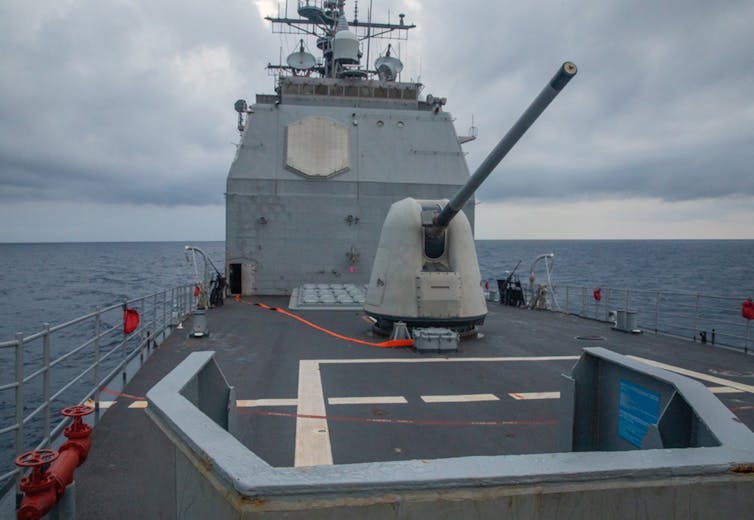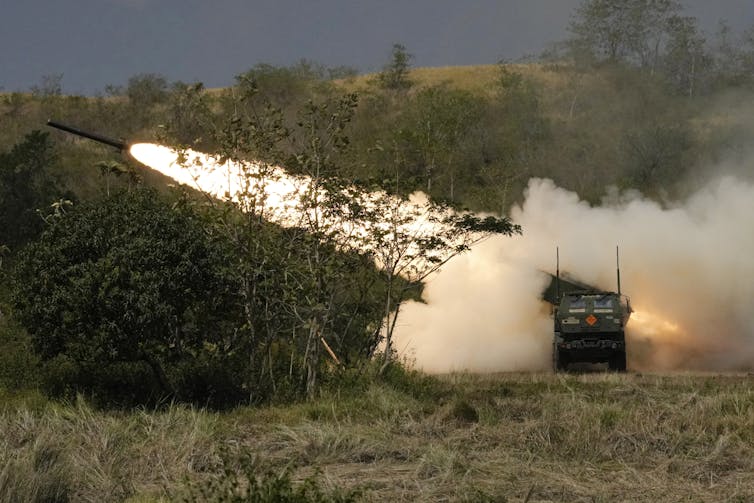Before today’s release of the government’s defence strategic review, Defence Minister Richard Marles said it would be the most important examination of Australia’s defence capabilities since the 1986 “Dibb Report” authored by Professor Paul Dibb.
As such, direct comparisons of the two documents were already being made before today’s release.
The Dibb Report told a compelling story. It began by stating unequivocally that Australia was “one of the most secure countries in the world” and argued we should adopt a “strategy of denial”, which would
allow our geography to impose long lines of communication on an adversary and force an aggressor to consider the ultimate prospect of fighting on unfamiliar and generally inhospitable terrain.
The Dibb Report maintained the sea and air gap to Australia’s north could be made impassable if the Australian Defence Force (ADF) leveraged its technological edge in naval, air and surveillance capabilities. In turn, the demonstrated ability of the ADF to sink or shoot down any enemy units attempting to cross the moat would deter other countries from deciding to attack.
Unsurprisingly, the Australian army saw itself as the big loser in the Dibb Report, being relegated to collecting any stray enemy forces that washed ashore across Australia’s northern coastline.
Three different schools of thought on defence
Today’s defence strategic review begins by outlining the fundamental geopolitical changes that have occurred in Australia’s region over the past few decades. The review is significant in openly stating the US no longer enjoys hegemony in the region, with China now being a great power peer and competitor.
In my book, Australia’s Defence Strategy, I identify several different traditions within Australian defence policy.
The first is that defence of the continent should be Australia’s preeminent strategic objective. There is some disagreement within this school of thought about whether Australia requires the capability to stop an opponent outright as it crosses the sea, air or cyber gap to attack Australia.
Or, as defence expert Hugh White tends to argue, simply making it too risky and costly for an enemy is sufficient to deter an attack.
The much-anticipated defence review is here. So what does it say, and what does it mean for Australia?
Another school of thought, which I call the “status quo defence policy” tradition, maintains that as long as there’s a favourable balance of power in our region, Australia will remain relatively secure.
This logic was once tied to imperial defence – as long as Britain ruled the waves, Australia would be relatively safe from attack.
Later, this thinking was redirected toward American primacy in the Asia-Pacific region. This viewpoint argued Australia’s defence was maintained by throwing our weight behind our great power security guarantor, even if it meant fighting far from our shores.
Finally, there is a tradition that argues defence thinking has been too focused on traditional threats from other nations. Defence policy should be treated as “national security”, which would better capture threats emerging from non-state actors such as terrorists, failed states, infectious diseases and climate change.

US Navy handout/EPA
A convergence of the three traditions
We can clearly see the influence of all three of these traditions in the new defence strategic review.
First, the “strategy of denial” returns to the centre of Australia’s defence posture. Consequently, there is a strong emphasis on the security of the waters around Australia and our ability to prevent enemies from operating here.
The army sees itself being sidelined again and is less than pleased. Retired Major General Mick Ryan, for example, describes the government’s planned cut of infantry fighting vehicles from 450 to 129 as “a kick in the guts to the army”.
Although the defence strategic review means the army will be asked to head in a very different direction from the one it had hoped to follow, it should not believe it is once again being relegated to Australia’s strategic goalkeeper.
The review argues for the accelerated acquisition of medium- and heavy-landing craft and the US-made High Mobility Artillery Rocket (HIMARS) system currently being used to great effect by Ukraine’s army against Russian forces. This would give Australia unprecedented long-range missile strike capability from land.
The intention is clearly to send the army forward to deny the sea, air and land to opponents far from Australia’s own coastline. My research team and I have previously analysed the geostrategic importance of Manus Island for such a role.
This reflects similar thinking in the US Marine Corps, under its Force Design 2030 restructuring plan, which will see land forces being deployed in maritime environments armed with long-range precision strike capabilities to restrict an opponent’s ability to manoeuvre.

Aaron Favila/AP
Doubling down on the American alliance
The defence strategic review also doubles down on Australia’s alliance with the US.
The 1986 Dibb Report argued the US was a global power with global interests and, consequently, Australia would be wise to emphasise “self-reliance” for all potential low- and medium-level conflicts.
The assumption in the current strategic review is that China is the greatest geopolitical challenge facing both Washington and Canberra, and this convergence of strategic interests and focus will result in a closer alliance between the two.
This section of the document reflects the “status-quo defence policy” tradition within Australian strategic thinking – if American power alone cannot maintain a favourable balance of power in the region, then Australia, Japan, India and other like-minded nations should throw their weight onto the scales.
A new threat: climate change
Finally, one of the most striking features of the review is the amount of time devoted to the impacts of climate change on the Australian Defence Force.
Although previous defence white papers have mentioned climate change, these references have generally only been made in passing. The review delves into far more depth and even advocates for defence procurement to move away from fossil fuels, which could have both positive operational and environment effects.
This follows the final school of thought on the importance of recognising non-traditional threats to our security, such as climate change.
Climate change poses a ‘direct threat’ to Australia’s national security. It must be a political priority
Why the review is happening now
Overall, the defence strategic review had extremely ambitious objectives and was produced on a very tight timeline.
A comparison with the Dibb Report allows for some strengths and weaknesses to be identified in the current review. Ironically, these strengthens and weaknesses can be seen as different sides of the same coin.
The review’s main strength is combining the main traditions of Australian strategic thought into one document. Its key weakness is that some of these traditions pull in different directions. The kind of capabilities Canberra would probably need to defend the Australian continent would not be best suited to contributing to US-led multinational coalitions across the Indo-Pacific.
1986 was a simpler time. The defence strategic review makes clear that a newly multipolar Asia will require a more nuanced and sophisticated defence posture.




